Even the calmest dog breeds need some form of exercise to remain healthy. And when you have an active pup? It gets difficult to keep up with their energy demands. So it’s easy to notice stiffness in the morning. Or when your dog slows down on their walks. Maybe you don’t hear tell-tale snaps and pops when your dog gets up and stretches, but their joints start to wear down. And crunchy elbows and hips? They’re painful. You don’t want your best friend to feel uncomfortable day in and day out. And that’s when you turn to one of the best dog joint supplements on the market.
Joint Pain in Dogs
When you think of joint pain – in dogs OR humans – you’re dealing with cartilage. Cartilage is the sponge-like material that sits between the bones of the joints, acting as a shock absorber. And while it’s tough enough to allow your dog to run and jump, it’s also on the delicate side.
Any time there’s an injury, the body releases enzymes that attack that cartilage. Over time (and with repeated inflammation), the cartilage starts to break down. You see this with athletes – regardless of how many feet they have.
And, unhappily, cartilage grows thinner with age. It goes from a nice, thick cushion to a thin wafer that stops supporting the joint. And when that happens, osteoarthritis (the fancy term for arthritis) sets in. And that’s where you start thinking about dog joint supplements.
Dysplasia
You can also have developmental problems where the joint fails to form properly. The cartilage can’t provide a cushion because the bones don’t line up the way they should. When this happens, your dog ends up with dysplasia. And it’s usually seen in the elbows or hips.
Dysplasia requires surgery to correct. Dog joint supplements WON’T help with the pain. Why? Because the joint is the problem – not the cartilage. Once a surgeon corrects things, they WILL recommend a supplement to keep your dog comfortable. But you need to step in and fix things in the first place.
Dysplasia is common in both tiny AND giant breeds.
Understanding Dog Joint Supplements
You’ll find hundreds of dog joint supplements on the market. And some of them make fantastic claims. But reality? It’s a little humbler. Similar to fish oils and probiotics, you’re adding a supplement to your dog’s diet – not a miracle. And some of the products out there do more harm than good.
Supplements AREN’T regulated by the FDA. This means you need to understand which ingredients are important, which may be dangerous (or even toxic), and which don’t do anything at all. While the hype SOUNDS good, it may not benefit your dog. And if you want the best dog joint supplements, you should talk to your veterinarian.
Vets agree these are the BEST ingredients to check for on labels (they have science-backed studies to prove they work):
- Glucosamine hydrochloride
- Chondroitin sulfate
- Omega-3 fatty acids
- ASUs
Glucosamine
One of the biggest components of dog joint supplements is glucosamine. And for a good reason: it helps build AND protect cartilage. However, there are two forms of glucosamine out there:
- Glucosamine hydrochloride (HCl)
- Glucosamine sulfate
You’ll find plenty of dog joint supplements with the sulfate version. Unhappily, the sulfate doesn’t reach your dog’s joints. So while your dog may benefit from the other ingredients in that supplement, they’re not getting the glucosamine you want in their cartilage. You need the hydrochloride version to make a difference.
For the best dosing (which you want to confirm with your vet), you start with 30mg/kg a day for the first MONTH. And, yes, it takes THAT LONG to have an effect (so you need some patience). After that, you’ll drop to 15mg/kg a day.
Chondroitin
Remember those pesky enzymes attacking your dog’s cartilage? Chondroitin stops them. It also pairs up nicely with glucosamine (this is why you often see them together). You CAN give chondroitin alone, but it’s tough on a dog’s GI tract. Mixed with glucosamine, you use a lower dose and make things easier on puppy tummies.
You use the same dose as you see in glucosamine (but confirm things with your vet).
Omega-3 Fatty Acids
If you’re already giving fish oils, you don’t need to look for them in your dog joint supplement. But having fatty acids keeps joints moving smoothly. They also help the heart and kidneys and keep your dog’s hair looking shiny.
You want fatty acids from fish or krill oil – NOT flaxseed oil. And while your vet can give you the best dose for your pup, an average of 100mg/kg of both the EPA and DHA levels is a good starting point.
ASUs
What are ASUs? Avocado soybean unsaponifables. They keep inflammation down and promote the healing of your dog’s joints. They also like to pair up with glucosamine and chondroitin. So if you can find a dog joint supplement with all three, you’ve hit gold.
Other Ingredients
You may find sites recommending other ingredients for dog joint supplements. However, they lack scientific backing. And, in some cases – such as with turmeric – they may be dangerous. Before you use ANY supplement, talk with your vet and review the label. Everyone understands you want to help your canine companion. And they’ll pitch in on the process – while making sure you’re not unintentionally doing any harm.
The Exception to the Rule
When you start looking for dog joint supplements, you need to keep one thing in mind. If your dog is in end-stage arthritis, these supplements won’t help. There’s simply no cartilage there to protect or heal.
Instead, you need to consider alternative treatments for pain, such as CBD oil.
Choosing a Dog Joint Supplement
You have your ingredient list, but there are THOUSANDS of dog joint supplements out there. How are you supposed to narrow down your search? By considering these important features:
- NASC Seal: You can’t look for FDA approval, but you CAN search for the National Animal Supplement Council (NASC) seal. They ensure companies use quality ingredients and perform quality control checks.
- Form: Dog joint supplements come in several forms, each with its pros and cons.
- Chews: Dogs like the treat, but the ingredients aren’t the best, and ingredient concentrations are lower.
- Powder or Liquid: You get better quality and higher concentrations here. The taste isn’t always the best, though, causing dogs to refuse to eat their meal.
- Tablet: Tablets have the highest concentrations and the best ingredients. However, if you can’t get your pup to swallow it, you’re out of luck.
- Safety: You should see a lot number on the bottle. This indicates the company performs quality control.
- Size: How many chews or tablets does your dog need to meet their dose? Is it cost-effective for you? Or do you need to buy so many containers you’ll go broke?
- Ingredients: Read everything on the ingredient list. Do you see garlic or other potential problems?
Are Human Supplements Okay?
While you may see similar ingredients on your daily supplement bottle, NEVER give your dog a human supplement. The doses aren’t the same, and there are often other ingredients YOU can digest and handle that dogs CAN’T. It’s much safer to stick to dog joint supplements.
Again, bring your chosen product to your vet and review everything with them. They’ll make sure your pup stays safe. And this way the two of you can put any other plans together. (For instance, in case your dog needs to start a weight-loss plan to remove excess strain on their joints)
The Best Dog Joint Supplements
When your happy-go-lucky pup starts slowing down and playing less, it causes concern. And while no one’s figured out how to slow down the aging process yet, you CAN step in and slow down the destruction of your dog’s joints. Dog joint supplements protect cartilage from damage. And they even repair some of the wear-and-tear. It’s a handy little daily dose that accomplishes a lot.
And if you combine the supplement with other things such as hydrotherapy or laser therapy? You’ll see your dog bouncing back to their old selves. But remember – it’s a slow process, and you won’t see results overnight. (And if any of the dog joint supplements make that claim – run the other way)
If you’re looking for a cost-effective dog joint supplement, Doggie Dailies works out well. You get a one-pound jar packed with around 225 chews. Each chew contains 100mg of glucosamine HCl and 50mg of chondroitin. You’ll also see MSM and yucca for extra anti-inflammatory help. And they include salmon and cod liver oil for a boost of omegas. You can choose from chicken or peanut butter to give your pup a choice between their favorite flavors.
Downsides? You won’t get much glucosamine HCl from this supplement. It may be enough for small dogs, but it’s not enough for the bigger pups out there. And since dogs with sensitive tummies ended up with some GI upset following these chews, you don’t want to overdo it. You’ll also want to consider storage carefully since you have those fish oils. It’s nice to have a large jar, but the chews will go bad FAST if it doesn’t close.
The Good
- Soft chews
- 100mg of glucosamine HCl
- 50mg of chondroitin
- Includes omegas
The Bad
- Dose of glucosamine low
- Some GI upset
- Store carefully due to large jar size
Some dogs won’t tolerate chews OR tablets. That’s where Extend comes in. You get a liver-flavored powder you can add to your dog’s food, or you can mix it with water to create a tasty gravy. Each packet contains 1040mg of glucosamine HCl. And they throw in some vitamin C, for good measure. It makes the administration of a dog joint supplement easy for you.
The downsides? There’s no chondroitin in this particular supplement. Instead, they include collagen. Collagen IS a building block for cartilage, but it won’t work the same way. Also, not every dog likes the flavor, and if they don’t eat it, it won’t help.
The Good
- Flavored powder
- 1040mg of glucosamine HCl
The Bad
- No chondroitin
- Some GI upset
- Not all dogs like the liver flavor
Infinite offers two formulas for you: a chewable tablet or a powder you can sprinkle and mix into your dog’s food. The dose for either offers 250mg of glucosamine sulfate and 100mg of chondroitin. Both use a beef liver flavor dogs approve of. They also give you a lifetime money-back guarantee – which is always helpful.
The downsides? You saw it: this isn’t a dog joint supplement with glucosamine HCl. So your dog won’t be getting any help for their cartilage. Also, it features turmeric, which vets don’t want canines receiving. (The long list of “claims” Infinite attaches should tip you off) And, if you choose to go with this supplement, the dosing comes out on the low end.
The Good
- Chewable tablet or powder
- 100mg of chondroitin
- Lifetime money-back guarantee
The Bad
- 250mg of glucosamine sulfate
- Contains turmeric
- Dose of glucosamine low
Nutramax carries plenty of veterinarian endorsements, and it’s been used in clinical trials over the years. Every tablet contains 600mg of glucosamine HCl and 300mg of chondroitin. And everything comes packed into a handy chicken-flavored tablet your dog can chew, OR you can hide in a treat without too much trouble.
So what are the downsides? Some people struggled to break the tablets if they needed a smaller size. And with artificial flavoring, not every dog enjoyed the taste. You may need to break out the peanut butter.
The Good
- Veterinary-endorsed
- Chewable tablet
- 600mg of glucosamine HCl
- 300mg of chondroitin
The Bad
- Difficult to break tablet
- Not all dogs like chicken flavor
When you’re looking for a dog joint supplement that covers all the bases, comes with the NASC seal, and won’t break the bank, Nutri-Vet does the trick. The chewable tablet comes with a liver flavor most dogs don’t mind, and they aren’t the worst to break apart (if you need). Every tablet comes complete with 500mg of glucosamine HCl and 400mg of chondroitin. They even throw in some extra minerals to keep your dog healthy. You have three strengths to choose from, and they offer three different sizes.
Downsides? Not every dog approves of the flavor. And if they won’t eat it, it won’t help. Also, they’re a little on the pricier side of things.
The Good
- Chewable tablet
- 500mg of glucosamine HCl
- 400mg of chondroitin
- Available in 3 strengths
- Available in 3 sizes
The Bad
- Expensive
- Not all dogs like liver flavor
PetHonesty focuses on minimizing potential allergens in their dog joint supplement. They skip corn, sugar, and wheat in favor of carrots, sweet potatoes, and tomatoes. Of course, you also get 625mg of glucosamine HCl and 210mg of chondroitin. And they throw in turmeric, eggshell, and yucca, for good measure. It’s a healthy balance in a chicken-flavored treat your dog will love.
Downsides? Yeah, there’s turmeric and TOO MUCH of it. It comes close to passing up the glucosamine level. People also saw GI upset. That’s when they got their dogs to eat the treat in the first place.
The Good
- Chewable tablet
- 625mg of glucosamine HCl
- 210mg of chondroitin
The Bad
- Contains excessive turmeric
- Some GI upset
- Not all dogs like chicken flavor
Looking for that NASC seal? PetNC proudly displays it. And each soft chew includes 250mg of glucosamine HCl and 100mg of chondroitin. All wrapped in a liver flavor dogs love. You also won’t have to break the bank to bring one of these tubs home (in theory).
The downsides? The glucosamine comes in on the low side. And if you have a bigger dog? The tub won’t last you very long. It doesn’t cost much – until you have to buy multiples of them each month. They also use several extracts, including green tea and rosemary. While not toxic, some people have reported GI upset and other problems. You may want to proceed carefully.
The Good
- NASC seal
- Soft chews
- 250mg of glucosamine HCl
- 100mg of chondroitin
The Bad
- Dose of glucosamine low
- Some GI upset
- Not cost-effective for large dogs
PlanoPaws is careful to leave out known allergy triggers from their dog joint supplement – as well as the sugar. That means no corn, wheat, or soy. Instead, they narrow the focus of their chicken or peanut butter soft chews to the primary ingredients. That means 625mg of glucosamine HCl and 210mg of chondroitin. You’ll also see eggshell meal (for collagen) and yucca. All packed into a large container that should last any pup plenty of time.
So what are the downsides? They use WAY more turmeric than other dog joint supplements – almost as much as they do the glucosamine! Your dog doesn’t need it. You’re likely going to see GI upset. And the collagen isn’t going to help as much, making it an extra ingredient.
The Good
- Soft chews
- 625mg of glucosamine HCl
- 210mg of chondroitin
- Available in 2 flavors
The Bad
- Contains excessive turmeric
- Some GI upset
ProSense is another dog joint supplement that keeps things simple. In every chewable tablet, your pup gets 650mg of glucosamine HCl and 200mg of chondroitin. They’ll also get a little vitamin C. It’s a basic tablet, flavored with brewer’s yeast, and most dogs don’t mind the taste. The bottle’s cost-effective, and it comes with that all-important NASC seal of approval.
Downsides? Not every dog likes the flavor, of course. And they ARE larger tablets, which may be difficult to administer if you have a smaller pup.
The Good
- NASC seal
- Chewable tablet
- 650mg of glucosamine HCl
- 200mg of chondroitin
The Bad
- Not all dogs like yeast flavor
- Some GI upset
- Large tablets
Tired of only one size of dog joint supplement container to choose from? Synovi offers THREE. That makes it easier to cater to the needs of your pup and their daily dosing. The soft chews come packed with 450mg of glucosamine HCl, as well as green-lipped mussels, turmeric, and Boswellia extract. It’s a unique combination of herbs and shellfish that keep canine joints moving like new.
The downsides? Unhappily, there’s no chondroitin in the mixture. And none of the herbs can take its place. Also, some dogs turned up their nose at the smell (they’re supposed to taste like chicken, but they may not smell that way). And these are expensive dog joint supplements – no matter what size you get.
The Good
- NASC seal
- Soft chew
- 450mg of glucosamine HCl
The Bad
- Expensive
- No chondroitin
- Contains turmeric
- Not all dogs like smell
Vet IQ makes sure your dog gets plenty of healthy ingredients in its dog joint supplement. Every chicken-flavored soft chew contains 600mg of glucosamine HCl, and then they add in 210mg of krill oil and 280mg of fish oil. It’s the perfect blend of omegas to keep your pup’s joints moving smoothly. And you get three different sizes to choose from in two different strengths, depending on how advanced your dog’s health may be.
So what are the downsides? Unhappily, you’re not going to get any chondroitin. It’s a shame since they added those healthy omegas to the mix. And some dogs decided they didn’t like the flavor.
The Good
- Soft chew
- 450mg of glucosamine HCl
- 210mg of krill oil and 280mg of fish oil
- Available in 2 strengths
- Available in 3 sizes
The Bad
- No chondroitin
- Not all dogs like chicken flavor
When you need the highest level of ingredients possible, you look to VetPro. A standard dose is two chicken-flavored chews. And each dose contains 1000mg of glucosamine HCl, 200mg of chondroitin, and 100mg of omegas. It’s a hefty punch that should work for pups of any size. And with around 120 treats in every jar, it’s not a bad option, cost-wise.
Downsides? It does contain turmeric. You’ll need to make the call on whether you feel comfortable offering the herb to your dog or not. Some dogs ended up with GI upset. There IS molasses in the ingredients, too, so extra sugar could be the cause. Also, depending on your dog’s weight, you may need to dish out quite a few. That could lead to excessive sugar.
The Good
- Soft chew
- 1000mg of glucosamine HCl
- 200mg of chondroitin
- 100mg of omegas
The Bad
- Contains turmeric
- Contains molasses
- Some GI upset
For dogs with an active lifestyle, you’ll want to consider VetriScience. They pack in 1000mg of glucosamine HCl and green-lipped mussel. It’s a nice combination designed to protect your dog’s joints from damage. And the soft chews come in a chicken liver flavor pups love. You get the all-important NASC seal on the bag, too.
The downsides? While ideal for dogs recovering from surgery or working every day, this isn’t an ideal dog joint supplement. It doesn’t contain chondroitin. So you won’t stop further damage from occurring. It’s also pricey. And while described as a “soft chew,” owners found them on the hard side.
The Good
- NASC seal
- Soft chew
- 1000mg of glucosamine HCl
The Bad
- Expensive
- No chondroitin
- Harder chew
You know dogs can’t receive aspirin. And that’s where Vets Best comes in. It’s a dog joint supplement that includes extras for pain relief. Namely, pineapple bromelain and white willow bark (where aspirin came from). Every liver-flavored tablet contains 250mg of glucosamine HCl, with yucca as a bonus. You’ll help soothe your dog’s joints and calm down any inflammation there, all at the same time.
So what are the downsides? No chondroitin, unhappily. And if you’re seeing joint damage, you want to slow it down as much as possible. Also, while white willow bark ISN’T aspirin, you don’t want to administer it every day. So this isn’t the best dog joint supplement option out there. And if your dog’s in daily pain, you need to have a conversation with your vet.
The Good
- NASC seal
- Chewable tablet
- 250mg of glucosamine HCl
The Bad
- Low dose of glucosamine
- No chondroitin
- Not ideal for daily administration
Zesty Paws offers you three different flavors for your dog joint supplement: duck, chicken, and (every dog’s favorite) bacon. It makes this soft chew a cinch to give. And every treat contains 450mg of glucosamine HCl and 125mg of chondroitin. You also get kelp (a nice source of vitamins) and yucca. And to avoid common dog allergies, they avoid corn, grain, and soy.
So what are the downsides? There’s only one size of the jar, and it comes out on the expensive side. They DO also add in omegas, but it’s from flaxseed, so your dog won’t benefit from them. And they use palm tree oil which can cause GI upset.
The Good
- Soft chew
- 450mg of glucosamine HCl
- 125mg of chondroitin
- Available in 3 flavors
The Bad
- Expensive
- Omegas from flaxseed
- Some GI upset
Less Pain, More Gain
An uncomfortable dog makes YOU uncomfortable. How can you step in and help? Dog joint supplements are a great start. And since they’re tasty, most canines don’t mind them. Your pup gets the glucosamine and chondroitin their joints need, and you get a sigh of relief. Just make sure to coordinate the supplement with your veterinarian.
And you can always consider other alternatives, too. Exercise doesn’t have to mean chasing down a frisbee over harsh terrain. Swimming is non-impact and helps preserve joint health! Regaining that mobility is key, and you’ll feel wonderful when your dog starts moving freely again.


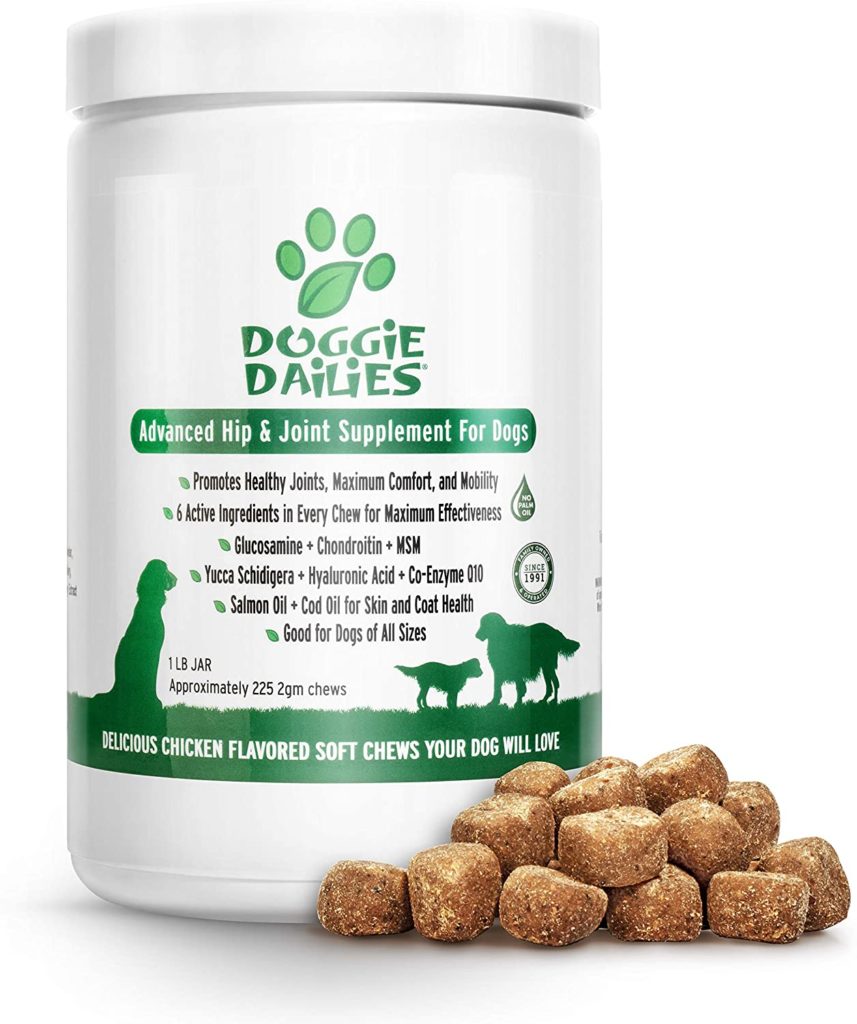
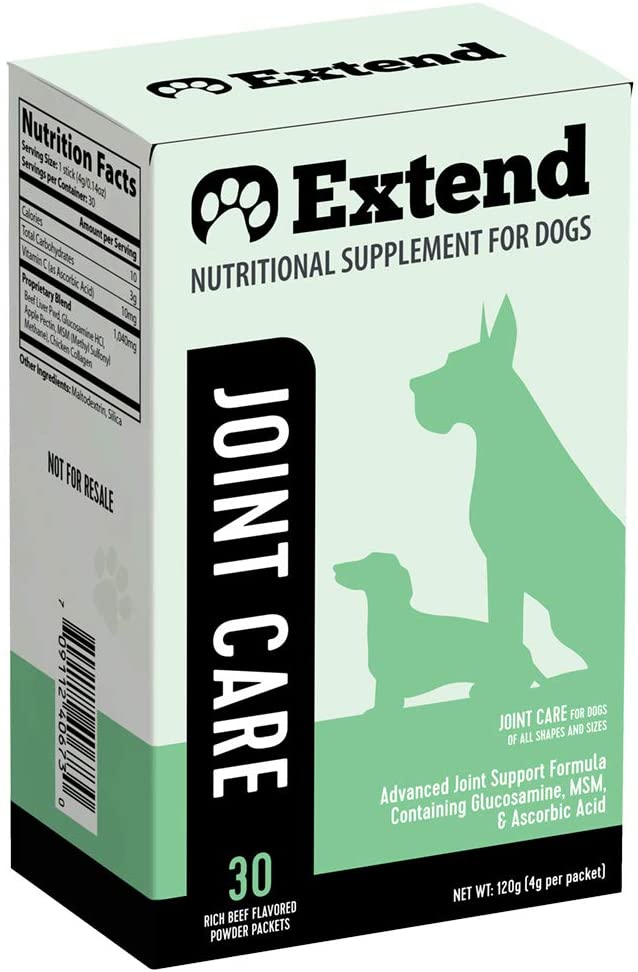
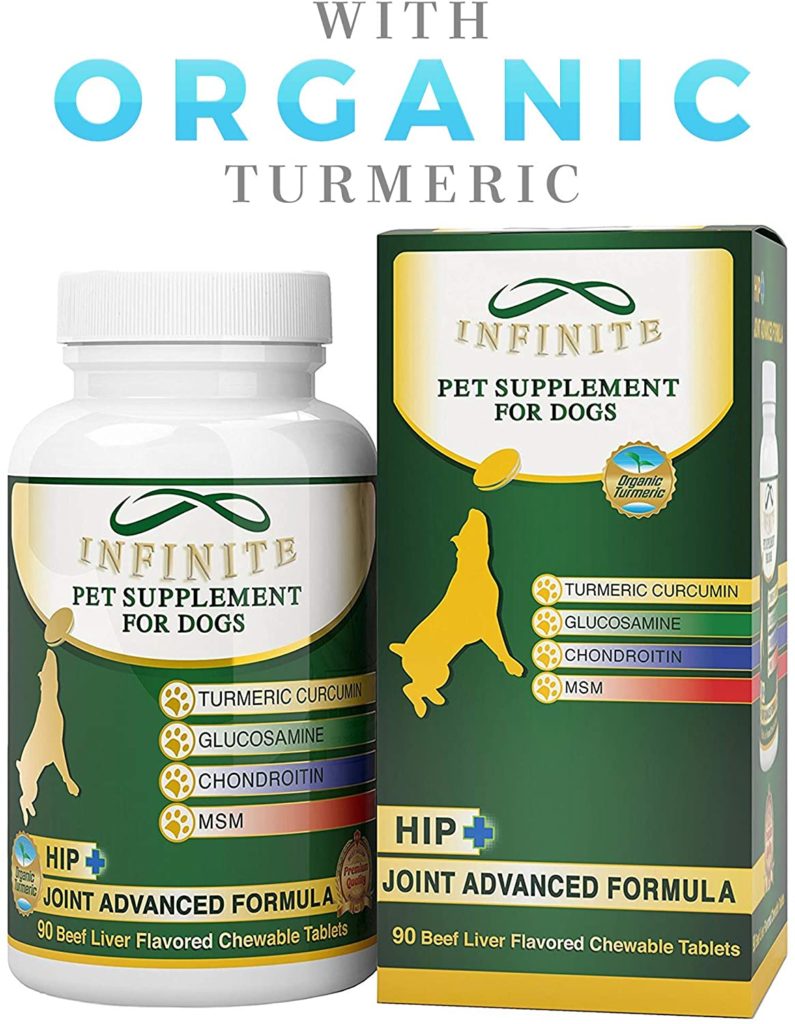
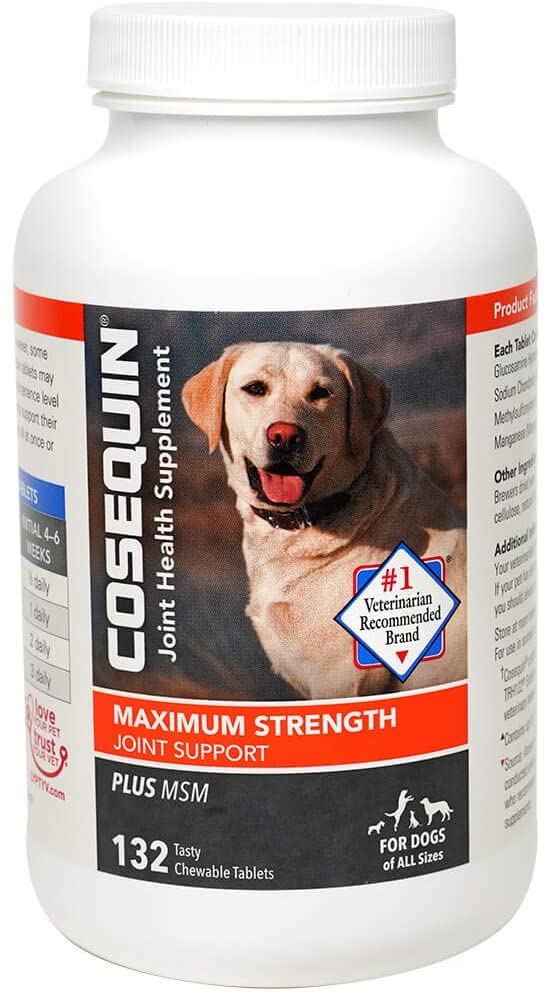
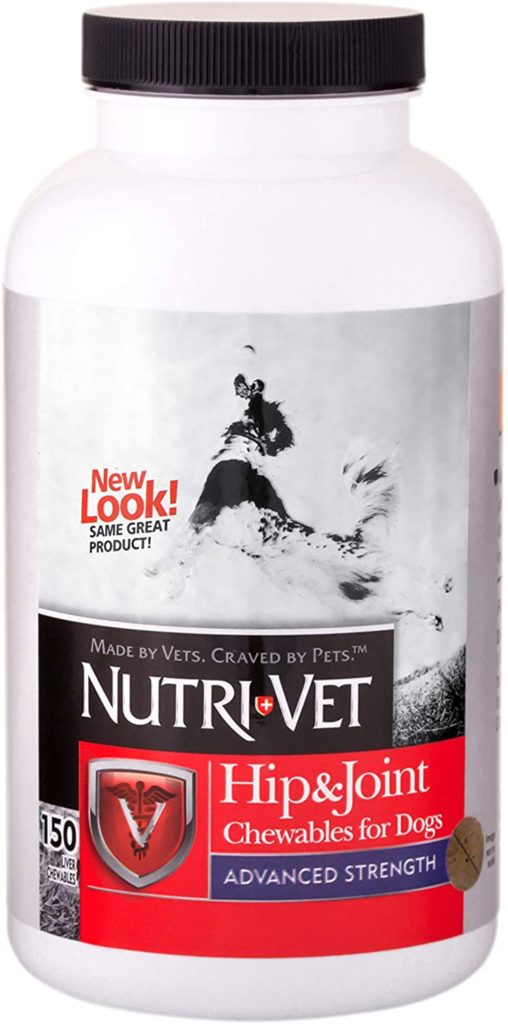
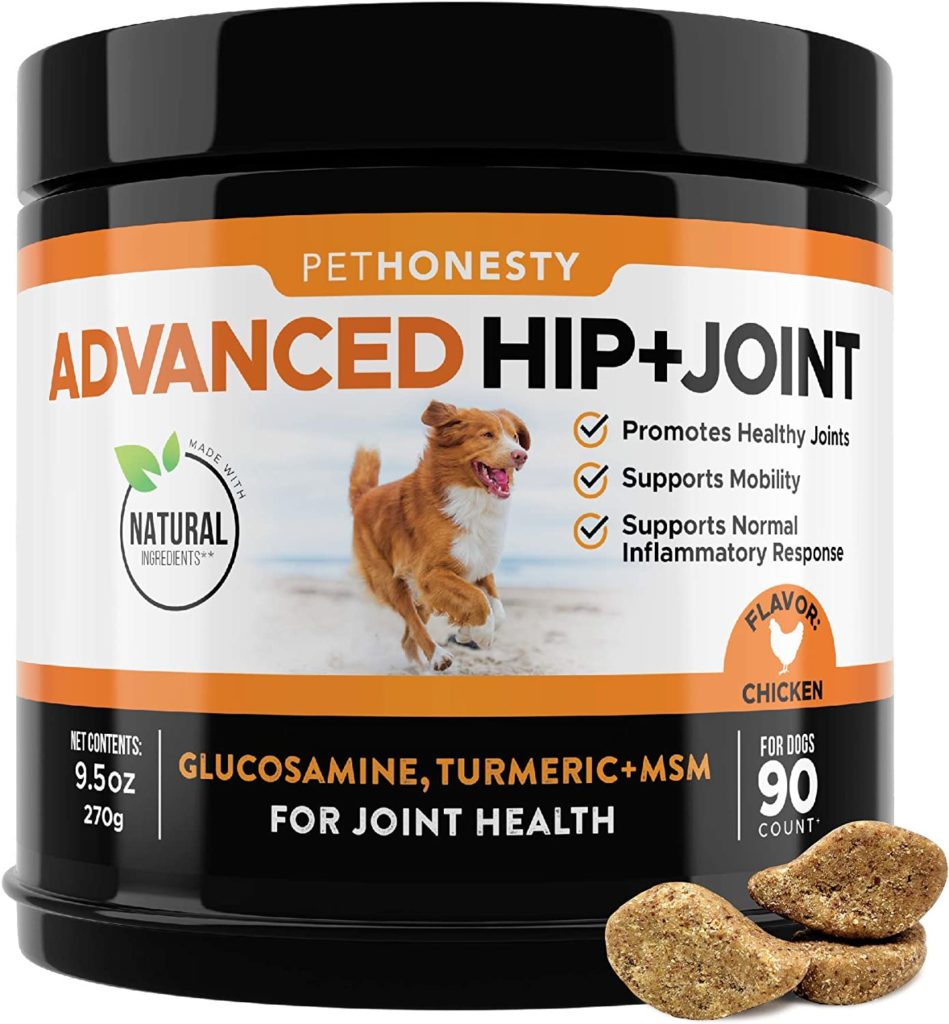
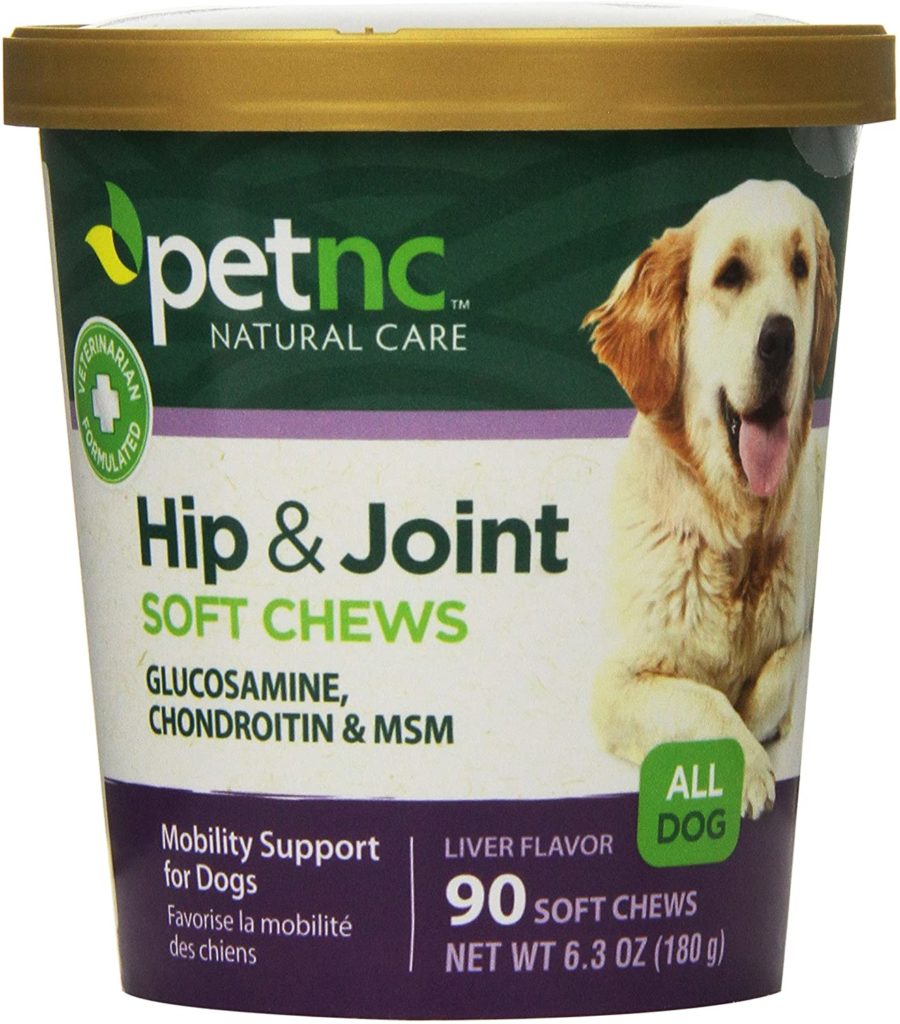
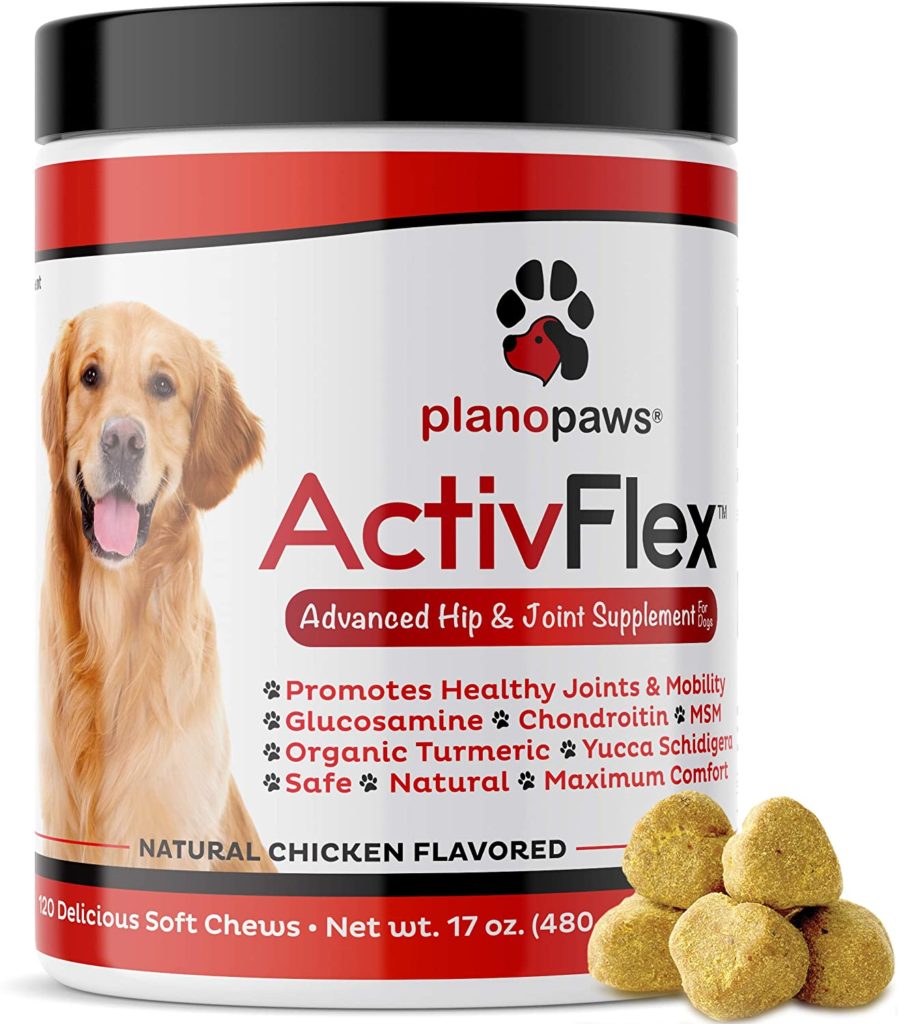
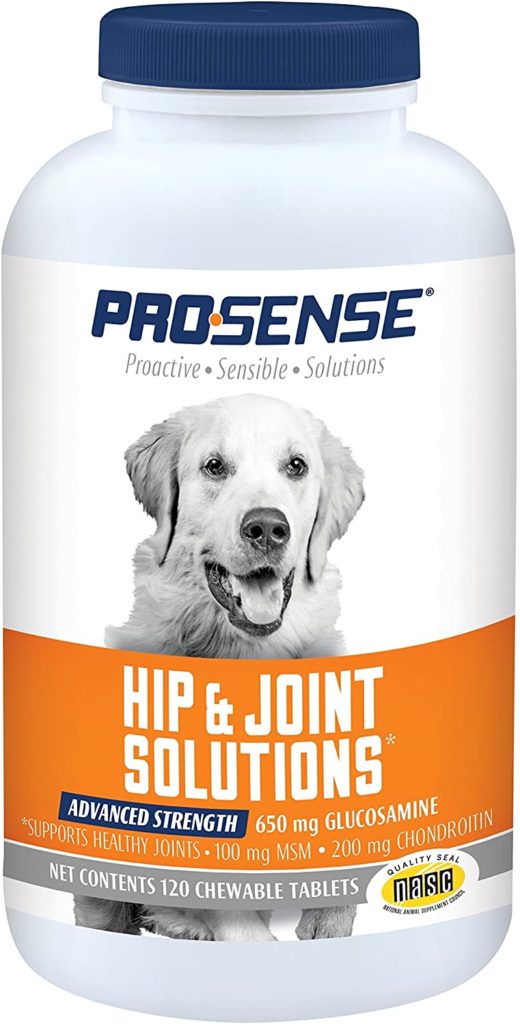
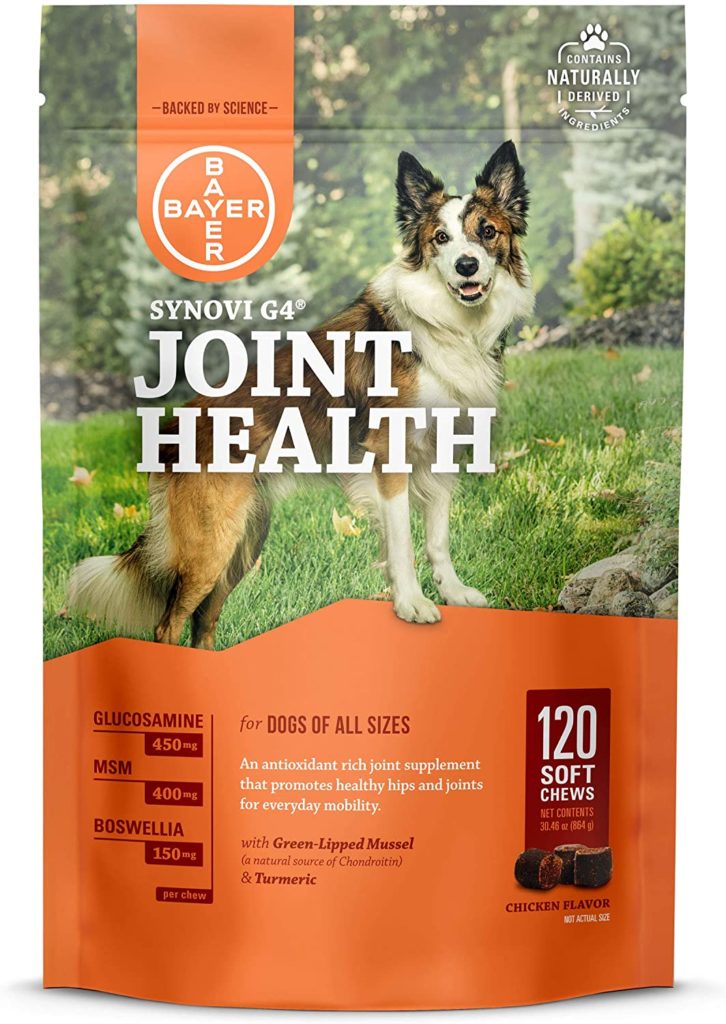
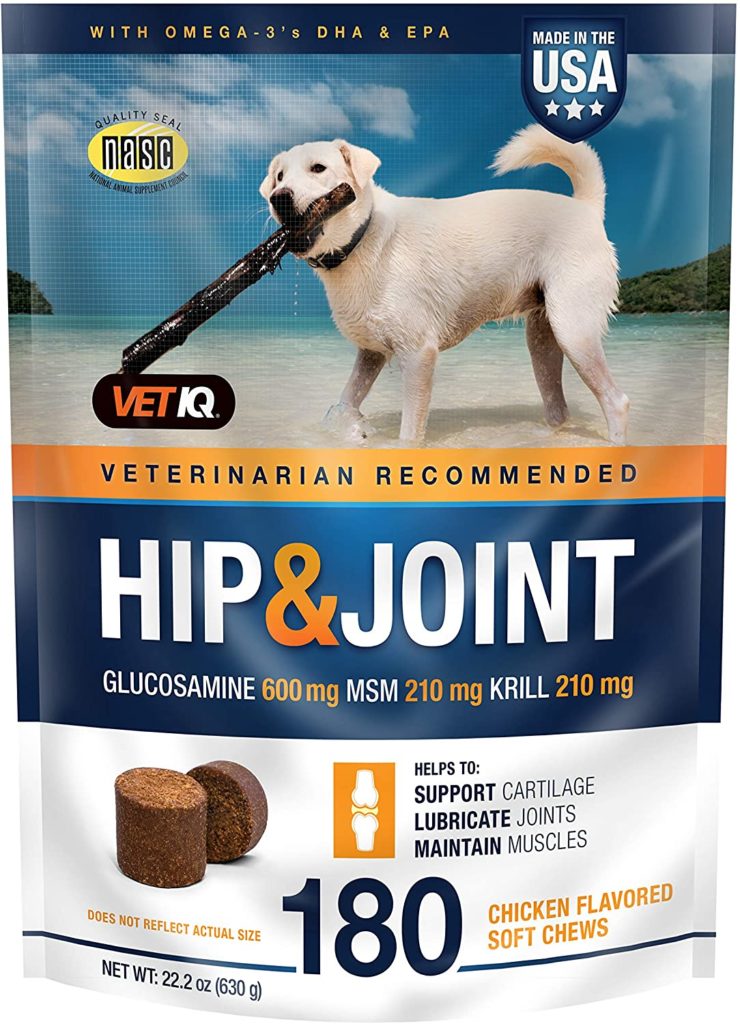
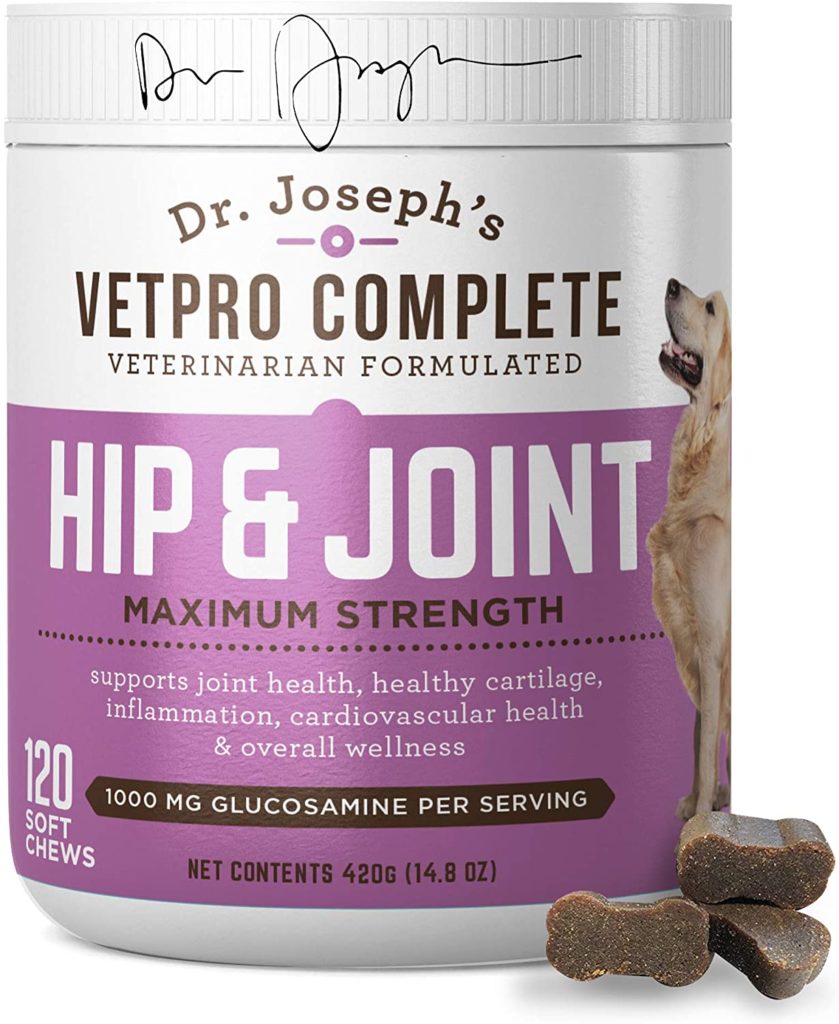
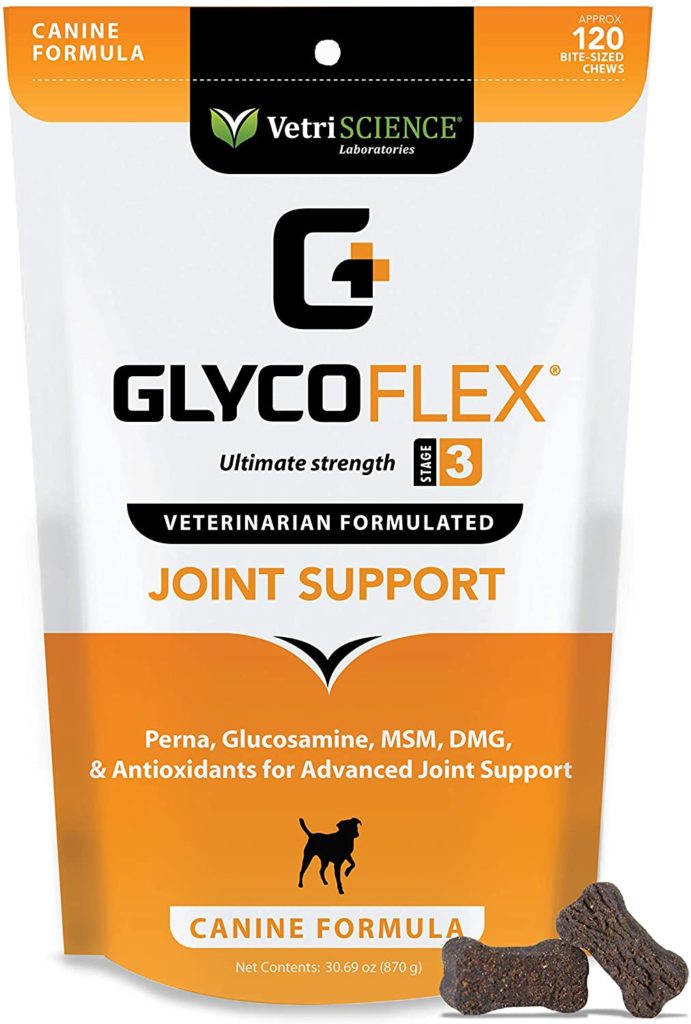
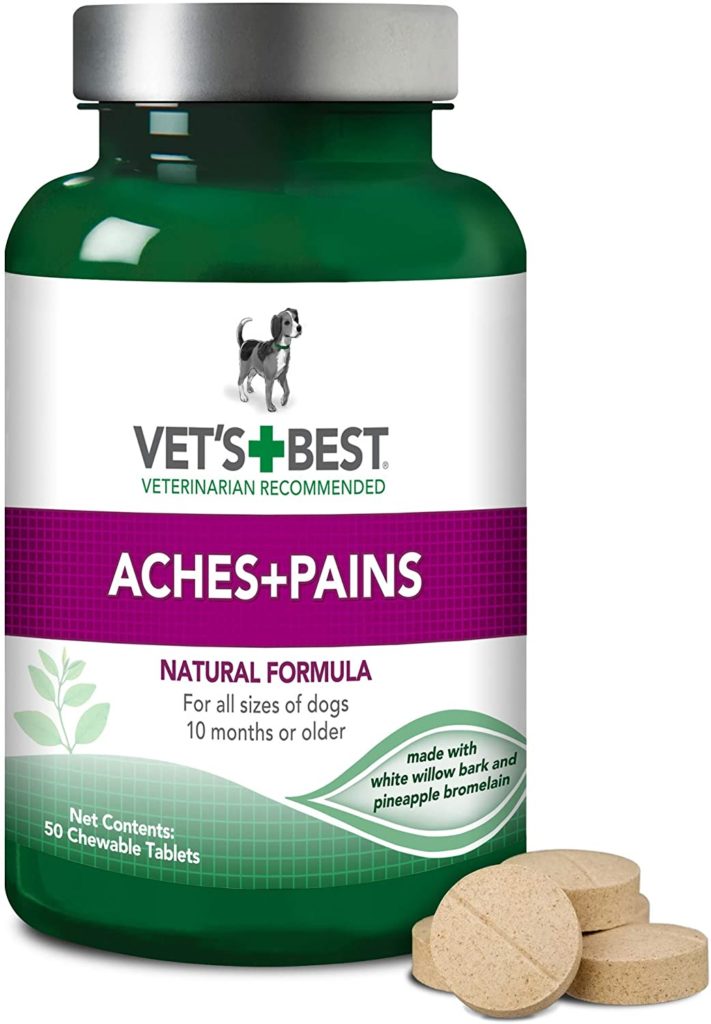
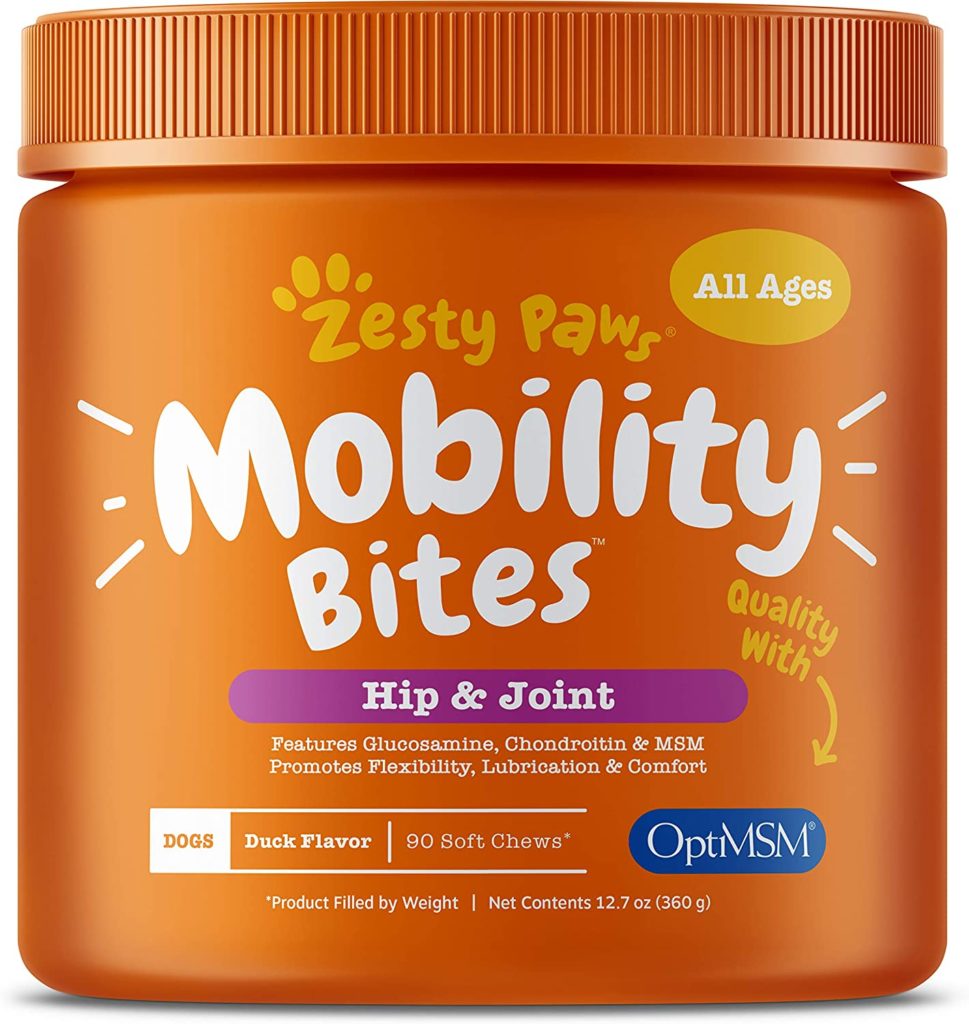



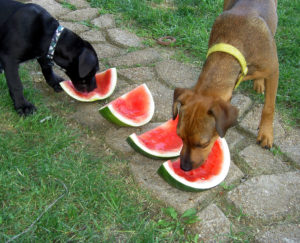
No comment yet, add your voice below!